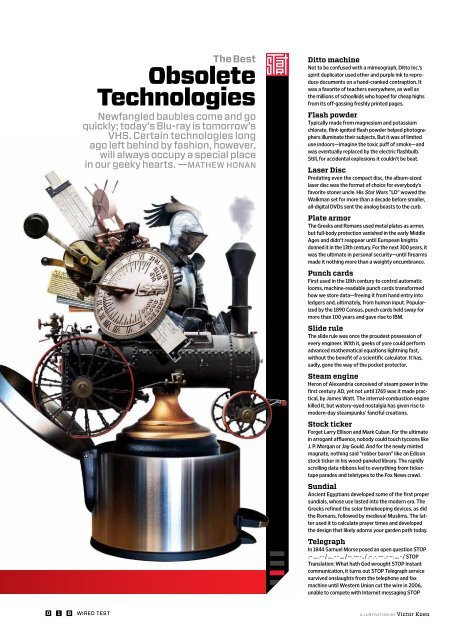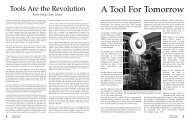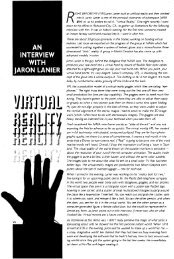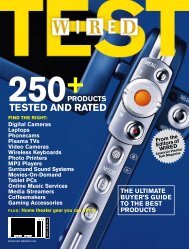You also want an ePaper? Increase the reach of your titles
YUMPU automatically turns print PDFs into web optimized ePapers that Google loves.
0 1 8 WIRED TEST<br />
The Best<br />
Obsolete<br />
Technologies<br />
Newfangled baubles come and go<br />
quickly; today’s Blu-ray is tomorrow’s<br />
VHS. Certain technologies long<br />
ago left behind by fashion, however,<br />
will always occupy a special place<br />
in our geeky hearts. —MATHEW HONAN<br />
Ditto machine<br />
Not to be confused with a mimeograph, Ditto Inc.’s<br />
spirit duplicator used ether and purple ink to reproduce<br />
documents on a hand-cranked contraption. It<br />
was a favorite of teachers everywhere, as well as<br />
the millions of schoolkids who hoped for cheap highs<br />
from its off-gassing freshly printed pages.<br />
Flash powder<br />
Typically made from magnesium and potassium<br />
chlorate, flint-ignited flash powder helped photographers<br />
illuminate their subjects. But it was of limited<br />
use indoors—imagine the toxic puff of <strong>sm</strong>oke—and<br />
was eventually replaced by the electric flashbulb.<br />
Still, for accidental explosions it couldn’t be beat.<br />
Laser Disc<br />
Predating even the compact disc, the album-sized<br />
laser disc was the format of choice for everybody’s<br />
favorite stoner uncle. His Star Wars “LD” wowed the<br />
Walkman set for more than a decade before <strong>sm</strong>aller,<br />
all-digital DVDs sent the analog beasts to the curb.<br />
Plate armor<br />
The Greeks and Romans used metal plates as armor,<br />
but full-body protection vanished in the early Middle<br />
Ages and didn’t reappear until European knights<br />
donned it in the 13th century. For the next 300 years, it<br />
was the ultimate in personal security—until firearms<br />
made it nothing more than a weighty encumbrance.<br />
Punch cards<br />
First used in the 18th century to control automatic<br />
looms, machine-readable punch cards transformed<br />
how we store data—freeing it from hand entry into<br />
ledgers and, ultimately, from human input. Popularized<br />
by the 1890 Census, punch cards held sway for<br />
more than 100 years and gave rise to IBM.<br />
Slide rule<br />
The slide rule was once the proudest possession of<br />
every engineer. With it, geeks of yore could perform<br />
advanced mathematical equations lightning fast,<br />
without the benefit of a scientific calculator. It has,<br />
sadly, gone the way of the pocket protector.<br />
Steam engine<br />
Heron of Alexandria conceived of steam power in the<br />
first century AD, yet not until 1765 was it made practical,<br />
by James Watt. The internal-combustion engine<br />
killed it, but watery-eyed nostalgia has given rise to<br />
modern-day steampunks’ fanciful creations.<br />
Stock ticker<br />
Forget Larry Ellison and Mark Cuban. For the ultimate<br />
in arrogant affluence, nobody could touch tycoons like<br />
J. P. Morgan or Jay Gould. And for the newly minted<br />
magnate, nothing said “robber baron” like an Edison<br />
stock ticker in his wood-paneled library. The rapidly<br />
scrolling data ribbons led to everything from tickertape<br />
parades and teletypes to the Fox News crawl.<br />
Sundial<br />
Ancient Egyptians developed some of the first proper<br />
sundials, whose use lasted into the modern era. The<br />
Greeks refined the solar timekeeping devices, as did<br />
the Romans, followed by medieval Muslims. The latter<br />
used it to calculate prayer times and developed<br />
the design that likely adorns your garden path today.<br />
Telegraph<br />
In 1844 Samuel Morse posed an open question STOP<br />
.-- .... .- - / .... .- - .... / --. --- -.. / .-- .-. --- ..- --. .... - / STOP<br />
Translation: What hath God wrought STOP Instant<br />
communication, it turns out STOP Telegraph service<br />
survived onslaughts from the telephone and fax<br />
machine until Western Union cut the wire in 2006,<br />
unable to compete with Internet messaging STOP<br />
ILLUSTRATION BY Victor Koen








